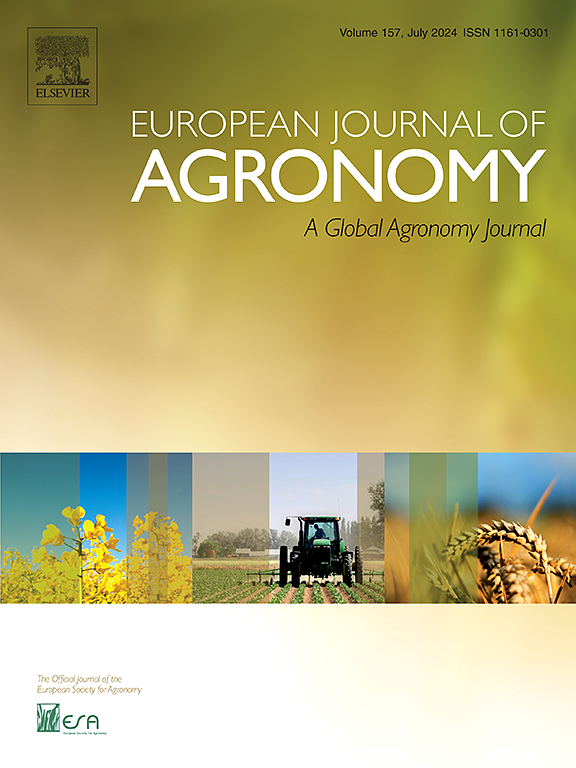耕作对冬小麦生产力和土壤肥力的影响:瑞士西部13年免耕的结果
IF 5.5
1区 农林科学
Q1 AGRONOMY
引用次数: 0
摘要
了解不同耕作方式如何影响作物生产力和土壤肥力对发展可持续农业系统至关重要。本文研究了免耕对冬小麦产量和土壤肥力的影响,并与常规耕作、浅耕和少耕进行了比较。2007-2020年期间,4种耕作方式对冬小麦产量的影响不显著。而免耕的相对年产量最低,产量变异性最大。冬小麦籽粒品质主要受土壤质地的影响,而不受耕作方式的影响。耕作方式对土壤有机碳、全氮和交换性钾、镁储量的影响显著,仅在最上层10cm处,3种不倒耕处理的土壤有机碳、全氮和交换性钾、镁储量的影响较大。然而,当对整个50 cm深土壤剖面进行评估时,不同耕作方式之间的养分储量差异不显著。微生物生物量碳在土壤剖面上有明显的分层现象,免耕和免倒耕的最上层土壤生物量碳较大。总体而言,我们的数据表明,即使免耕在作物产量方面仍处于过渡阶段,其对土壤有机碳和微生物生物量的积极影响在13年后仍可观察到。此外,我们强调,至少在当地条件下,最少的耕作是一种非常合适的做法,可以提供多种农艺和环境优势。本文章由计算机程序翻译,如有差异,请以英文原文为准。
Effects of tillage on winter wheat productivity and soil fertility: Results from 13 years of no-till in western Switzerland
Understanding how different tillage practices affect crop productivity and soil fertility is essential for developing sustainable agriculture systems. Here we investigated how no-till affected winter wheat yield and soil fertility after 13 years since its introduction in a clay and a loam soil compared to conventional ploughing, shallow tillage and minimum tillage. During the study period 2007–2020 the annual yield of winter wheat did not differ significantly among the four tillage treatments. However, the no-till showed the lowest relative annual yield and the largest yield variability. The quality of winter wheat grains was affected primarily by the soil texture than by the tillage treatment. A significant effect of tillage on the stocks of soil organic carbon, total nitrogen and exchangeable potassium and magnesium was observed only in the topmost 10-cm, where larger values were found for the three non-inversion tillage treatments. However, when the entire 50-cm deep soil profiles were evaluated, only non-significant differences in nutrient stocks were detected between tillage treatments. We observed a clear stratification of microbial biomass carbon along the soil profile with larger values in the topmost soil layers in the no-till and the non-inversion minimum tillage. Overall, our data indicate that even if the no-till may still be in a transition phase in terms of crop yield, its positive effects on soil organic carbon and microbial biomass are observable after 13 years. In addition, we underline as the minimum tillage appears, at least under the local conditions, as a very suitable practice providing multiple agronomic and environmental advantages.
求助全文
通过发布文献求助,成功后即可免费获取论文全文。
去求助
来源期刊

European Journal of Agronomy
农林科学-农艺学
CiteScore
8.30
自引率
7.70%
发文量
187
审稿时长
4.5 months
期刊介绍:
The European Journal of Agronomy, the official journal of the European Society for Agronomy, publishes original research papers reporting experimental and theoretical contributions to field-based agronomy and crop science. The journal will consider research at the field level for agricultural, horticultural and tree crops, that uses comprehensive and explanatory approaches. The EJA covers the following topics:
crop physiology
crop production and management including irrigation, fertilization and soil management
agroclimatology and modelling
plant-soil relationships
crop quality and post-harvest physiology
farming and cropping systems
agroecosystems and the environment
crop-weed interactions and management
organic farming
horticultural crops
papers from the European Society for Agronomy bi-annual meetings
In determining the suitability of submitted articles for publication, particular scrutiny is placed on the degree of novelty and significance of the research and the extent to which it adds to existing knowledge in agronomy.
 求助内容:
求助内容: 应助结果提醒方式:
应助结果提醒方式:


